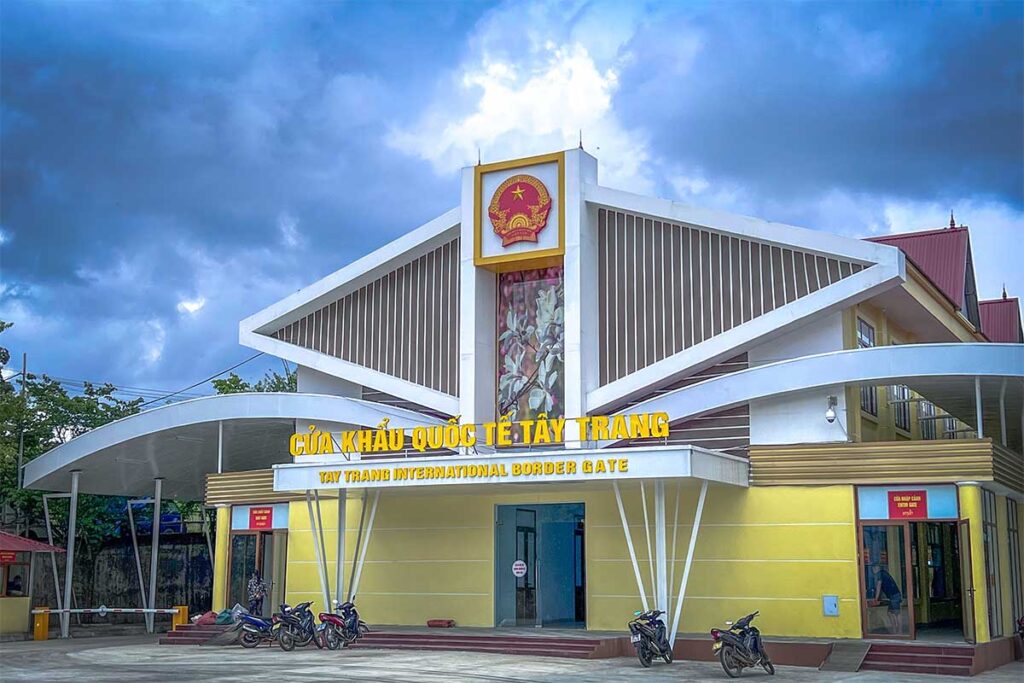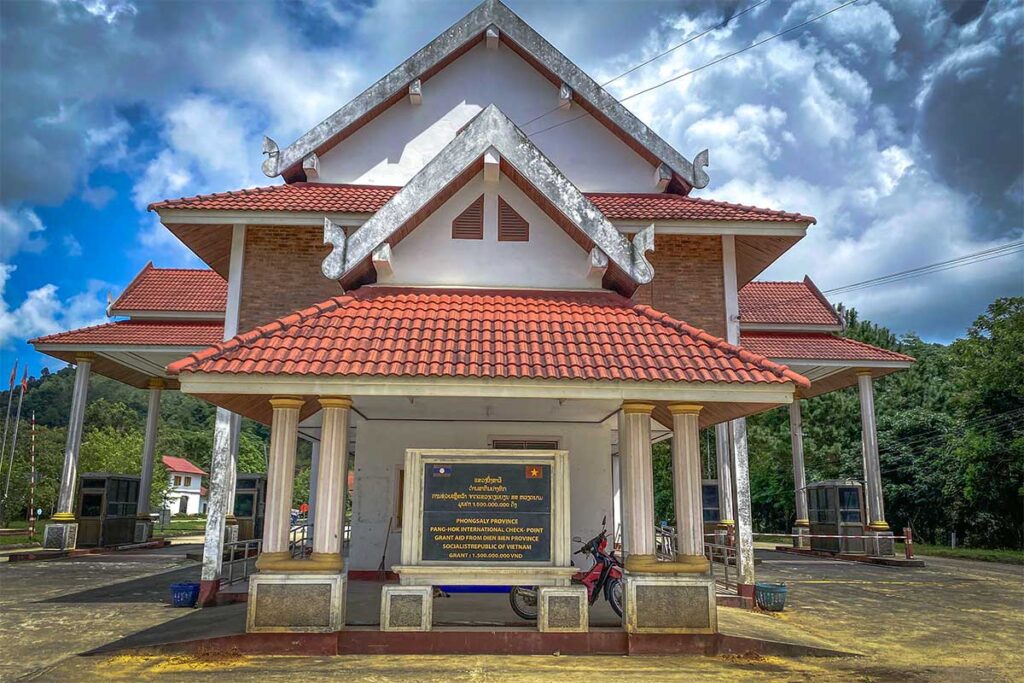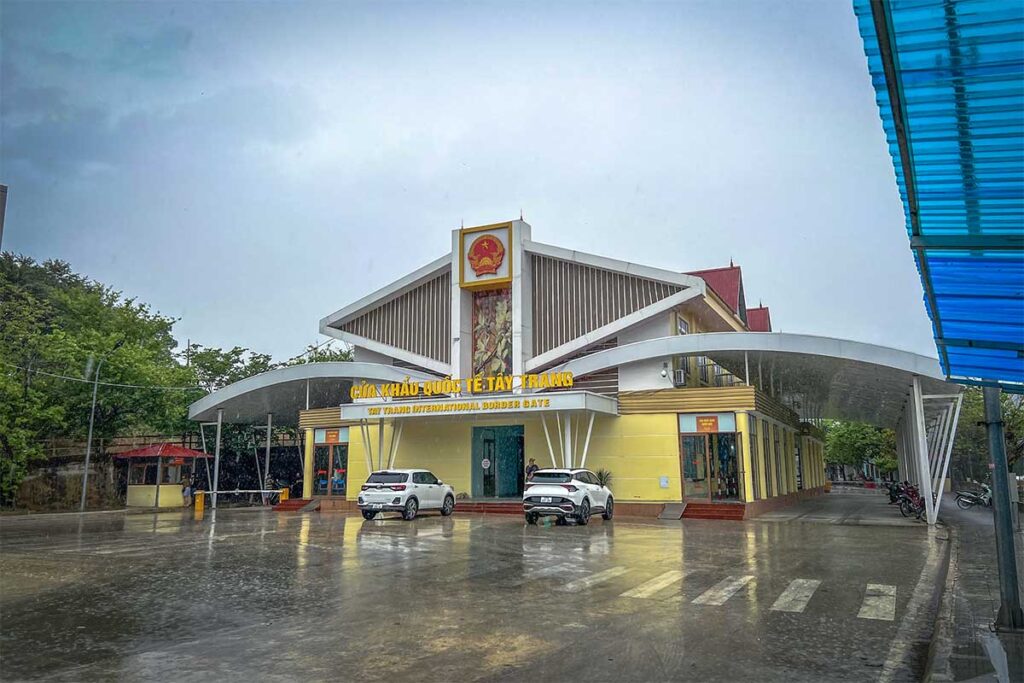Laos–Vietnam border crossing at Dien Bien Phu
Tay Trang Border Crossing Station (Vietnam)

The Vietnamese border checkpoint is called Tay Trang, located around 35 km from Dien Bien Phu. The station itself is isolated, with no real town nearby—just a few immigration buildings, occasional vendors, and sometimes an informal money changer. The road to the border is hilly and often dusty, especially with truck traffic from nearby construction or quarry sites.
Sop Hun Border Checkpoint (Laos)

On the Lao side, the corresponding border checkpoint is known as Sop Hun, though some sources or maps may refer to it as Pang Hoc. Like Tay Trang, it’s in a remote mountain area with little infrastructure beyond the immigration post. The nearest Lao towns are Muang Mai (about 30 km) and Muang Khua (about 65 km), both of which are possible destinations after crossing.
How does the border crossing work?
The overall procedure is straightforward if you’re traveling by bus, but it can be much more difficult if you’re going independently. Here’s a step-by-step breakdown of how it works:
Step 1 – Exit Vietnam at Tay Trang
Your bus will stop at the Tay Trang checkpoint where everyone disembarks. Bring your passport and head into the immigration building to receive your Vietnam exit stamp. This usually goes smoothly, but if you’re walking or arriving by private vehicle, you’ll need to arrange your own ride from Dien Bien Phu as there’s no public transport to the border.
Step 2 – Travel Between the Two Checkpoints
After exiting Vietnam, there’s a stretch of roughly 4–5 km between the two border stations. If you’re on a bus, you’ll simply drive through this “no man’s land.” Independent travelers may have to walk or hitchhike this part—some have waited for trucks or relied on military or local vehicles to get across.
Step 3 – Enter Laos at Sop Hun
Once at the Laos checkpoint, you’ll disembark again to complete entry procedures. Make sure you have a valid stamped visa from the Lao embassy (usually done in Hanoi), as e-visas and visas on arrival are not accepted at this border. Officers may request small processing fees—only Lao Kip is accepted, so have some in advance.
Step 4 – Reboard or arrange onward travel
If you’re on a bus, you’ll get back on and continue toward Muang Mai, Muang Khua, or farther into Laos. If traveling independently, there are often no taxis or buses waiting on the Lao side, so you’ll need to hitchhike or wait for sporadic transport.
Step 5 – Be aware of border lunch closures
Both immigration offices typically close from 11:30 AM to 1:00 PM for lunch. If you arrive during this time, you’ll have to wait. On the Vietnamese side, there’s a small restaurant where travelers often sit out the break.
Important visa requirements
Visa rules at the Dien Bien Phu border crossing depend on the direction you’re traveling and your nationality. Unlike airports or major border points, this remote crossing has strict visa rules and no flexibility. Make sure you arrange everything in advance to avoid being denied entry.
Requirements entering Vietnam at Tay Trang Border
You cannot get a visa on arrival when entering Vietnam by land at Tay Trang.
To cross here legally, you must have one of the following:
- A Vietnam e-visa, and Tay Trang must be selected as your entry point during the application.
- A stamped visa issued by a Vietnamese embassy (though most embassies now refer travelers to the official e-visa site).
Important: The e-visa process can take several working days, so plan ahead. Arriving at the border without the correct visa will result in being turned away — there is no workaround. Read more about: how to apply for Vietnam e-visa.
Requirements entering Laos at Sop Hun Border
The Laos checkpoint at Sop Hun does not accept e-visas or visas on arrival.
You must obtain a physical Laos visa in advance, which is easiest to arrange at the Laos embassy in Hanoi. Most travelers receive it the same day if they apply in the morning.
At the border, there may be entry processing fees or informal charges, and these must be paid in Lao Kip — VND and USD are usually not accepted. It’s best to exchange money in Dien Bien Phu or with vendors near the Vietnam border post.
No exceptions are made for travelers without the correct visa. Many have been denied entry for assuming they could use an e-visa or get a visa on arrival.
Motorbike restrictions and limitations
Crossing the Dien Bien Phu border with a motorbike is possible only under very specific conditions, and many travelers have run into problems here. If you’re planning to ride across, it’s important to understand the limitations.
- Only Vietnamese motorbikes registered in Dien Bien Province (license plate 27…) are allowed to exit into Laos at this crossing.
- Bikes registered in Hanoi, Ho Chi Minh City, or other provinces are routinely denied passage, regardless of ownership documents or blue cards.
- Some travelers have attempted to negotiate or pay “fees” to bypass the restriction, but these efforts are almost always unsuccessful.
- There is no reliable or official process for applying for a special permit, and border officers often reference a printed regulation or checklist to justify the refusal.
- As a result, several travelers have ended up selling or abandoning their bikes in Dien Bien Phu.
Returning from Laos into Vietnam with a motorbike can also be problematic. While the Laos side may allow exit, Vietnamese border agents sometimes require customs paperwork that was never issued in the first place, especially for foreigners. Unless your bike is registered in Dien Bien and you’re prepared with extensive documentation, it’s best not to attempt this crossing by motorbike.
Traveling between Dien Bien Phu and Hanoi (or Sapa)
Whether you’re arriving in Vietnam from Laos or heading toward the border to exit, Dien Bien Phu is your key connection point in the far northwest. From here, you can reach Hanoi or Sapa by bus, plane, or private vehicle. Here’s what you need to know:
By bus
This is the most common and affordable option. Several sleeper and VIP buses run daily between Dien Bien Phu and Hanoi, taking 10–12 hours.
- Buses usually depart in the afternoon or evening and arrive early morning in Hanoi (typically 3:00–5:00 AM).
- In Dien Bien Phu, most buses leave from the main station or Duc Thang Hotel area.
- Booking is best done via your hotel or a bus office—avoid taxi drivers or random agents who may overcharge or mislead.
There are also direct sleeper buses between Dien Bien Phu and Sapa or Lao Cai, though less frequent. These typically depart in the evening and arrive early morning. Expect basic comfort.
By flight
Vietnam Airlines sometimes operates flights between Hanoi and Dien Bien Phu, but schedules are inconsistent and prone to changes due to weather or low demand. It can be a quick option if available, but always check up-to-date schedules before planning your trip around it.
By private car or van
A private transfer is possible but expensive, given the long mountain route (around 450 km). It’s an option for groups or those wanting more comfort, but rarely used due to cost. Some travelers combine it with a larger private tour or itinerary through the northwest.
Traveling into Laos or from Laos to the Border
Whether you’re crossing from Vietnam into Laos or from Laos into Vietnam, transportation options on the Laos side are limited and often require a mix of planning and flexibility. Here’s how to navigate both directions:
From Vietnam into Laos – Where to go next
Once you’ve crossed into Laos at the Sop Hun checkpoint, the nearest towns are:
- Muang Mai – about 30 km from the border. It’s a quiet rural stop with limited facilities, suitable if you need a short break before continuing.
- Muang Khua – about 65 km from the border and the most popular onward destination. It has basic guesthouses, food options, and good onward transport.
Getting there:
- If you’re on a bus from Dien Bien Phu to Muang Khua, you’ll continue directly.
- If you’re traveling independently, transport from the Laos border is unreliable. There are no taxis or regular buses. Many travelers end up hitchhiking or waiting until they can join a passing vehicle (including tourist buses or local trucks).
From Muang Khua, travelers often:
- Take a slow boat to Muang Ngoi or Nong Khiaw, two scenic riverside towns.
- Continue by road to Oudomxay or further toward Luang Prabang.
From Laos to Vietnam – How to reach the border
If you’re heading toward Vietnam, your goal is to reach the Sop Hun border crossing, but it can be tricky without a tour or direct bus.
Best options:
- Muang Khua: This is the main hub.
- A bus to the border leaves around 7:30 or 10:00 AM (but schedules are not reliable).
- Ask your guesthouse or locals to confirm the latest time and departure location.
- The bus takes 2.5–3 hours to reach the border.
- Muang Ngoi or Nong Khiaw:
- Travel to Muang Khua first by boat or van, then follow the above route.
Tips:
- Arrive at the border early, as most buses from Laos reach it in the morning.
- No transport operates in the afternoon, so if you miss the window, you may need to stay overnight in Muang Khua.
- Make sure you’ve arranged your Vietnam visa in advance and selected Tay Trang as your entry point.
Tips for crossing the Dien Bien Phu Border
Crossing this border can be smooth if you’re prepared, or a frustrating experience if you’re not. Below are practical tips to help avoid delays, confusion, and common mistakes—especially for independent travelers.
Get the right visa
- To enter Laos, you need a physical visa stamped in your passport from the Laos embassy (usually done in Hanoi). No e-visas or visa on arrival are accepted at this border.
- To enter Vietnam, an e-visa is accepted, but Tay Trang must be selected as your entry point during the application. There is no visa on arrival for Vietnam.
Bring Lao Kip in advance
- You’ll likely need to pay small fees on the Laos side, and only Lao Kip is accepted.
- Change money in Dien Bien Phu before heading to the border, or with informal money changers near the Vietnamese checkpoint.
Book a Bus — Don’t cross on foot or independently
- There’s a 4–5 km stretch between the Vietnam and Laos checkpoints, and no official transport in between.
- If you’re not on a bus, you may have to walk or hitchhike through this isolated area — not ideal, especially in bad weather or with luggage.
- Some officers rent out scooters, but they’re overpriced and not always reliable.
Unless you have no other choice, it’s strongly recommended to book a bus that crosses the border. Buses wait for passengers at each checkpoint, guide you through the paperwork, and eliminate most of the hassle.
Avoid crossing during lunch gours
- Both border offices typically close from around 11:30 AM to 1:00 PM.
- If you arrive during this time, you’ll have to wait.
- There’s a basic restaurant on the Vietnam side where many travelers pass the time.
Don’t attempt crossing with motorbike (Unless registered in Dien Bien)
- Only motorbikes registered in Dien Bien (plate 27…) are allowed to cross.
- Even with all paperwork, other bikes (from Hanoi, HCMC, etc.) are regularly turned away.
- There’s no clear process for special permits, and many travelers have had to sell or leave their bikes behind.
Keep your Laos Entry/Exit Slip
- When entering Laos, you’re given a small slip alongside your passport stamp.
- Some officers mistakenly throw this away—insist on keeping it.
- You’ll need it when leaving Laos; without it, you may be fined.
Be cautious of scams or “Fees”
- Some border officials—especially on the Laos side—may request small unofficial payments.
- If you’re unsure, ask to see posted fee lists or politely question the charge.
- Avoid giving money without a clear and official reason.
Alternative ways to enter Laos
While the Dien Bien Phu border crossing works well for adventurous travelers heading to northern Laos, it’s not the only option — and not always the easiest. Here are some alternatives to consider, depending on your route, visa situation, and budget:
Other Vietnam–Laos Border Crossings
If you’re not set on going through Dien Bien Phu, you can consider other overland crossings:
- Na Meo – Nam Xoi: Good if you’re coming from Thanh Hoa or Ninh Binh, with onward access to Sam Neua and the Plain of Jars region.
- Nam Phao – Cau Treo: Popular route between Vinh (Vietnam) and Lak Sao (Laos).
- Lao Bao – Dansavanh: Ideal for those traveling from Hue or Dong Ha into Savannakhet in southern Laos.
Flying from Hanoi to Laos
If you want to skip the long bus journeys and uncertain overland procedures, flying is a convenient alternative:
- Hanoi to Luang Prabang – A direct flight takes about 1 hour and 15 minutes.
- Hanoi to Vientiane – Also available direct, about 1 hour and 30 minutes.
While flights are more expensive, they can save you time, hassle, and visa complications. This is especially worth considering if you’re on a tighter schedule or prefer a smoother entry into Laos.



